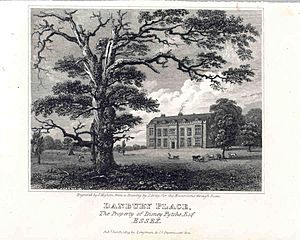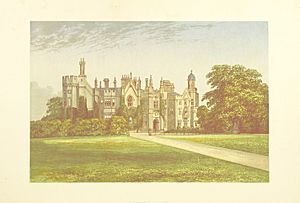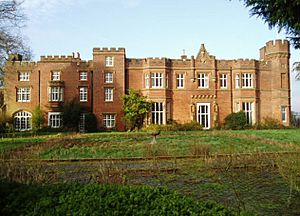Danbury Place facts for kids
Danbury Place was once a grand English country house. It was first built in 1589 by Walter Mildmay during the time of Queen Elizabeth I. This historic house stands on one of the highest spots in the county of Essex.
Around 1830, the original house was taken down. A new, large red brick mansion was built nearby and finished in 1832. In 1845, it became an episcopal palace, known as Danbury Palace. This meant it was the home of a bishop. It served this purpose until 1890.
The Story of Danbury Palace
Danbury Place belonged to the Mildmay family for many years. In 1673, John Mildmay passed away without children. His wife, Mary, later married Robert Corey. After Mary died in 1724, her daughter Elizabeth inherited the house. Elizabeth married William Fytche, and so Danbury Place became part of the Fytche family.
In 1750, the house went to William's younger son, Thomas Fytche. He had some work done on the house by a designer named Isaac Ware. Thomas died without children, so the house passed to his niece, Elizabeth. She was the daughter of William Fytche, who was briefly a governor in Bengal. In 1775, Elizabeth married Lewis Disney. He added Fytche to his name, becoming Lewis Disney Fytche.
Lewis Disney Fytche had five daughters. His wife passed away in 1787. The oldest daughter, Frances Elizabeth, married William Hillary in 1800. William Hillary bought the house from his father-in-law in 1801. He lived there with his young family.
In 1808, William Hillary and Elizabeth separated. He moved to the Isle of Man, while Elizabeth stayed at Danbury Place. She remained there until her father died in 1823. When Elizabeth passed away in 1828, the house was being rented out. William Hillary then sold Danbury Place to John Round.
John Round lived at Danbury Place. He had the old house replaced with a brand new one. This new house was designed by Thomas Hopper and finished in 1832. It was built in a style called Tudor Gothic, which looked like old English castles. After 12 years, the house changed again. It became an episcopal palace for the Bishop of Rochester. This is when its name officially changed to Danbury Palace.
Danbury Palace was put up for sale in 1892. It came with a large park of 284 acres. Seth Taylor bought it, and then sold it to Hugh Hoare. At the start of World War II, the house and its land belonged to John Tyson Wigan. He allowed it to be used as a maternity hospital, helping many new mothers and babies.
After the war, a big part of the park was bought by the local government, Essex County Council. In 1974, the house and other buildings went to Anglia Polytechnic University. This was also when the Danbury Country Park was created. The house was officially recognized as a Grade II Listed Building in 1987. This means it's an important historic building.
For about 30 years, Danbury Palace was used as a conference center by the university (which is now Anglia Ruskin University). In 2017, the university sold the Palace. Today, Danbury Palace has been changed into thirteen modern apartments.
The Park Around the Palace
Originally, Danbury Palace was surrounded by a deer park. This was a special area where deer roamed freely. By 1758, the park also had long rows of trees, called avenues.




